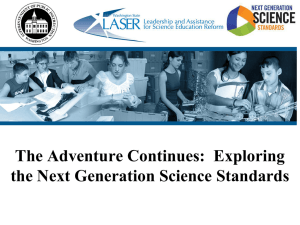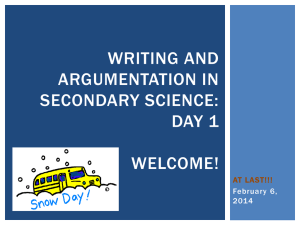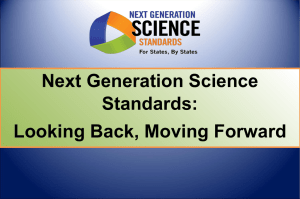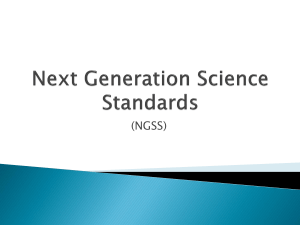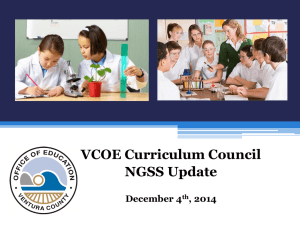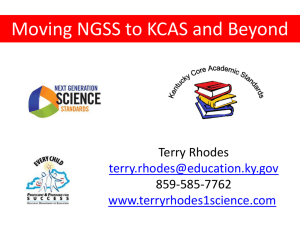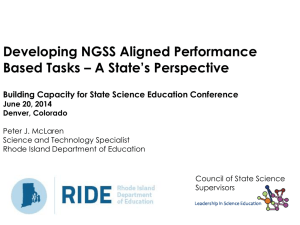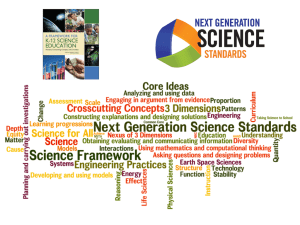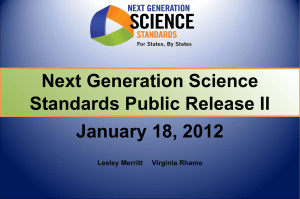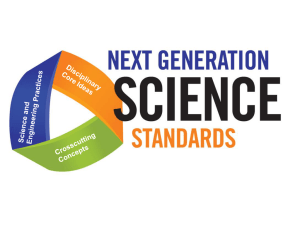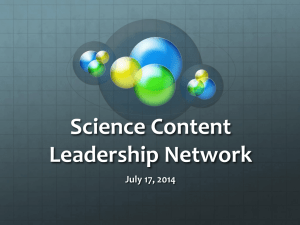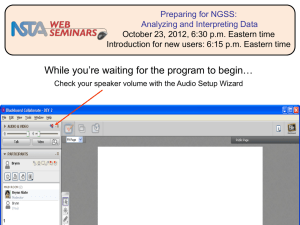Implementation of the Next Generation Science Standards
advertisement
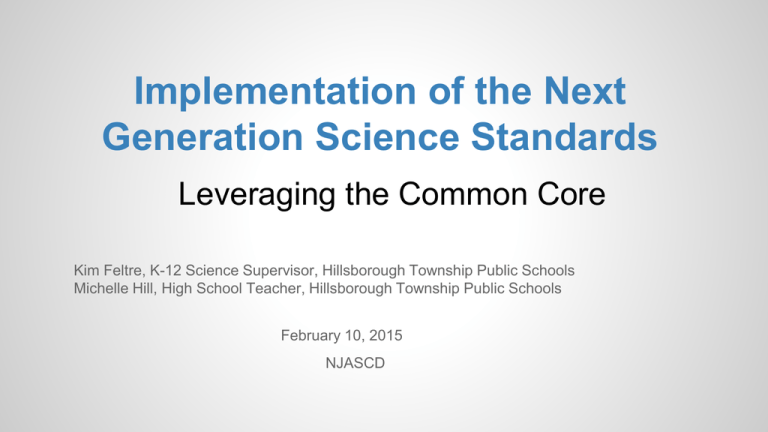
Implementation of the Next Generation Science Standards Leveraging the Common Core Kim Feltre, K-12 Science Supervisor, Hillsborough Township Public Schools Michelle Hill, High School Teacher, Hillsborough Township Public Schools February 10, 2015 NJASCD NORMS • • • • • • Recognize that there is more to learn than time permits so this work is fast-paced and warrants your full attention Stay attentive to the task at hand Ask questions and share your thinking Focus on what we can do Remain positive and constructive Have fun and celebrate learning! 2 THE POWER OF THE NGSS 3 NJCCCS DIFFERENCES FROM NGSS Science Practice Content Statement Performance Expectations Cumulative Progress Indicator 4 UNDERSTANDING THE NGSS Assessments Curricula Instruction Teacher Development To understand and successfully implement NGSS, it is CRITICAL to understand this Framework and its vision for science teaching and learning since it is the basis for the NGSS. 5 A FRAMEWORK FOR K-12 SCIENCE EDUCATION “the framework seeks to illustrate how knowledge and practice must be intertwined in designing learning experiences in K-12 science education” – NRC Framework for K-12 Science Education 6 INTEGRATION OF THE THREE DIMENSIONS The practices are the processes of building and using the core ideas to make sense of the natural and designed world, and the cross cutting concepts hold the discipline together. Practices Crosscutting Concepts Core Ideas 7 The Framework seeks to illustrate how knowledge and practice must be intertwined in designing learning experiences in K-12 science education. (Appendix E – p. 1) NGSS Science and Engineering Practices 1. Asking questions (for science) and defining problems (for engineering) 2. Developing and using models 3. Planning and carrying out investigations 4. Analyzing and interpreting data 5. Using mathematics and computational thinking 6. Constructing explanations (for science) and designing solutions (for engineering) 7. Engaging in argument from evidence 8. Obtaining, evaluating, and communicating information Disciplinary Core Ideas Physical Science • • • • Matter and its interactions Motion and stability:Forces and interactions Energy Waves and their applications in technologies for information transfer Life Science • • • • From molecules to organisms: structures and processes Ecosystems: interactions, energy, and dynamics Heredity: inheritance and variation of traits Biological evolution: unity and diversity Earth and Space Science • • • Earth’s place in the universe Earth’s systems Earth and human activity Crosscutting Concepts 1. Patterns 2. Cause and effect:mechanism and explanation 3. Scale, proportion, and quantity 4. Systems and system models 5. Energy and matter: flows, cycles, and conservation 6. Structure and function 7. Stability and change COMMON CORE STATE STANDARDS 9 CONCEPTUAL SHIFTS ● ● knowing about → figuring out recitation → reasoning COMMONALITY BETWEEN CCSS AND NGSS ALL the standards — math, ELA and science — require that teachers focus more attention on disciplinary “practices” There’s a common core in all of the standards documents (ELA, Math, and Science) At the core is: • Reasoning with evidence • Building arguments and critiquing the arguments of others • Participating in reasoning-oriented practices with others From: NSTA Webinar: “Connections Between Practices in NGSS, Common Core Math, and Common Core ELA”, by Sarah Michaels Feb 12, 2013 ACTIVITY ● Shake the jar (shake but don’t break) ● Record observations of the changes you see CER FRAMEWORK Claim - a conclusion about a problem (answers a questions) Evidence - scientific data that is appropriate and sufficient to support the claim Reasoning - a justification that shows why the data counts as evidence to support the claim and includes appropriate scientific principles Evidence Evidence Claim Evidence Reasoning Adapted from Toulmin (1958) CONCEPTUAL SHIFTS ● ● knowing about → figuring out recitation → reasoning SCIENCE AND ENGINEERING PRACTICES 1. Asking questions (for science) and defining problems (for engineering) 2. Developing and using models 3. Planning and carrying out investigations 4. Analyzing and interpreting data 5. Using mathematics and computational thinking 6. Constructing explanations (for science) and designing solutions (for engineering) 7. Engaging in argument from evidence 8. Obtaining, evaluating, and communicating information WHY ARGUMENTATION? argumentation – the action or process of reasoning systematically in support of an idea, action, or theory Joe Krajcik, NSTA Webinar: Preparing for the Next Generation Science Standards – Engaging in Argument from Evidence http://learningcenter.nsta.org/products/symposia_seminars/NGSS/webseminar11.aspx S&E Practice 7: Engaging in argument from evidence ENGAGING IN ARGUMENT FROM EVIDENCE Increasing sophistication Grades K-2 Make a claim and use evidence Grades 3-5 Middle School Construct and support scientific arguments drawing on evidence, data, or a model. Consider other ideas. Construct and present oral and written arguments supported by empirical evidence and reasoning to support or refute an explanation for a phenomenon. High School Construct a counter-argument that is based on data and evidence that challenges another proposed argument. Joe Krajcik, NSTA Webinar: Preparing for the Next Generation Science Standards – Engaging in Argument from Evidence Details in Appendix F – Science and Engineering Practices in the NGSS, p. 13 10 min break BENEFITS OF ARGUMENTATION FROM EVIDENCE How does engaging in argument from evidence help students? PRODUCTIVE TALK Fourth Graders Discussing What makes the water level rise: weight or volume? The Inquiry Project - http://inquiryproject.terc.edu/ DISCUSSION How did the teacher set up the classroom for productive talk? How did the students engage in argumentation from evidence? How did we set up the classroom for your activity to engage in productive talk? How does productive talk help visualize the linkage between CCSS ELA and the NGSS? LEVERAGING THE ELA COMMON CORE ● Speaking and Listening – 2 domains ■ comprehension and collaboration (SL.1-SL.3) ■ presentation of knowledge and ideas (SL.4-SL.6) conversation leads to building skills in reading and writing – speaking and listening serve as the foundation for reading and writing to happen as habits of mind LEVERAGING THE ELA COMMON CORE active learning involves the students being engaged in conversation How can we leverage speaking and listening skills in the science classroom? SCIENCE AND ENGINEERING PRACTICES 1. 2. 3. 4. 5. 6. Asking questions (for science) and defining problems (for engineering) Developing and using models Planning and carrying out investigations Analyzing and interpreting data Using mathematics and computational thinking Constructing explanations (for science) and designing solutions (for engineering) 7. Engaging in argument from evidence 8. Obtaining, evaluating, and communicating information Which of the science and engineering practices can be used to leverage the ELA Common Core? CONNECTIONS TO THE COMMON CORE 30 DISCIPLINARY CORE IDEAS Physical Science • • • • Matter and its interactions Motion and stability:Forces and interactions Energy Waves and their applications in technologies for information transfer Life Science • • • • From molecules to organisms: structures and processes Ecosystems: interactions, energy, and dynamics Heredity: inheritance and variation of traits Biological evolution: unity and diversity Earth and Space Science • • • Earth’s place in the universe Earth’s systems Earth and human activity Disciplinary Core Ideas: 1. Have broad importance across multiple sciences or engineering disciplines or be a key organizing principle of a single discipline. 2. Provide a key tool for understanding or investigating more complex ideas and solving problems. 3. Relate to the interests and life experiences of students or be connected to societal or personal concerns that require scientific or technological knowledge. 4. Be teachable and learnable over multiple grades at increasing levels of depth and sophistication. That is, the idea can be made accessible to younger students but is broad enough to sustain continued investigation over years. MIDDLE SCHOOL DISCIPLINARY CORE IDEAS (DCI) Physical Science (discipline) • Matter and its interactions (DCI) ● Structure and Properties of Matter (sub-idea) ● Chemical Reactions (sub-idea) • Motion and stability:Forces and interactions (DCI) ● Forces and Motion (sub-idea) ● Types of Interactions (sub-idea) • Energy (DCI) ● Definitions of energy (sub-idea) ● Conservation of energy and energy transfer (sub-idea) ● Relationship between energy and forces (sub-idea) ● Energy in chemical process and everyday life (sub-idea) • Waves and their applications in technologies for information transfer (DCI) ● Wave properties (sub-idea) ● Electromagnetic radiation (sub-idea) ● Information technologies and instrumentation (sub-idea) PERFORMANCE EXPECTATIONS • • Cannot be completed in a single lesson Is an endpoint or goal in the learning process Performance expectations combine practices, core ideas, and crosscutting concepts into a single statement of what is to be assessed. Performance expectations are NOT instructional strategies or objectives for a lesson. Which PE could this lesson inform and why? 45 minutes TALK MOVES Mathematical Discussion The Teaching Channel: Improving Participation with Talk Moves MATHEMATICS In Science: mathematics represents variables In Engineering: mathematics used to improve design SCIENCE AND ENGINEERING PRACTICES 1. Asking questions (for science) and defining problems (for engineering) 2. Developing and using models 3. Planning and carrying out investigations 4. Analyzing and interpreting data 5. Using mathematics and computational thinking 6. Constructing explanations (for science) and designing solutions (for engineering) 7. Engaging in argument from evidence 8. Obtaining, evaluating, and communicating information MATHEMATICS AND COMPUTATIONAL THINKING Mathematics Quantities and Units Mathematical Relationships Computational Thinking Mathematical Models Simulations COMPUTATIONAL THINKING In science: ● using computers to perform calculations ● way of using computers to help us model and understand the world ● manipulation and analysis of big data In engineering: ● simulations S&E Practice 5: Mathematical & Computational Thinking How would you describe the progression from K to 12? DEVELOPING AND USING MODELS ● A scientific model is an abstract, simplified representation of a system that makes its most important features explicit and visible. ● Models are external representations of mental (internal) concepts. Scientific modeling: ● Developing a model ● Evaluating a model ● Revising a model ● Using a model to illustrate, predict, or explain ANALOGY MAPS An analogy map is a tool to help students to better understand the parts of the model that they are using and how these parts relate to the world. An analogy map describes: ● Each part or feature of the model which includes objects and processes. ● The features of the real world that it represents. Ask students to critique the model: ● What does the model represent? ● What does the model NOT represent? ● Evaluating the uses for which the model might be more or less well suited. ACTIVITY Natural Selection PhET NATURAL SELECTION ANALOGY MAP Feature of the model Feature of the real world bunnies wolves time until next generation add a friend button population chart is/are like... because... REFLECTION • East-West: E – excites you; W – worries you West East RESOURCES ● Next Generation Science Standards - http://www.nextgenscience.org/nextgeneration-science-standards ● NSTA resources for NGSS - http://ngss.nsta.org/nsta-products-andservices/ ● Math CCSS - http://www.corestandards.org/Math/ ● ELA CCSS - http://www.corestandards.org/ELA-Literacy/ ● The Inquiry Project - http://inquiryproject.terc.edu/ ● The Teaching Channel - https://www.teachingchannel.org/videos ● Zemelman, S. Daniels, H. & Hyde, A. (2005). 3rd ed. Best practice: Today’s standards for tacheing and learning in America’s schools. Portsmoutn, NH: Heinemann. RESOURCES • Framework Chapter 3: Dimension 1: Scientific and Engineering Practices http://www.nap.edu/catalog.php?record_id=13165# • Appendix F – Science and Engineering Practices in the NGSS http://www.nextgenscience.org/sites/ngss/files/Appendix%20F%20%20Science%20and%20Engineering %20Practices%20in%20the%20NGSS%20-%20FINAL%20060513.pdf • Appendix I – Engineering Design in NGSS http://www.nextgenscience.org/sites/ngss/files/Appendix%20I%20%20Engineering%20Design%20in%20NGSS%20-%20FINAL_V2.pdf • Brian Reiser, NSTA Webinar: Preparing for the Next Generation Science Standards—Asking Questions and Defining Problems http://learningcenter.nsta.org/products/symposia_seminars/NGSS/webseminar5.aspx • Joe Krajcik, NSTA Webinar: Preparing for the Next Generation Science Standards – Engaging in Argument from Evidence http://learningcenter.nsta.org/products/symposia_seminars/NGSS/webseminar11.aspx • Sarah Michaels, NSTA Webinar: Connections Between Practices in NGSS, Common Core Math and Common Core ELA http://learningcenter.nsta.org/products/symposia_seminars/NGSS/files/ConnectionsBetweenPracticesin NGSSCommonCoreMathandCommonCoreELA_2-12-2013.pdf • Mariel Milano, NSTA Webinar: Engineering Practices in the NGSS http://learningcenter.nsta.org/products/symposia_seminars/NGSS/files/EngineeringPracticesintheNextG enerationScienceStandards_1-15-2013.pdf 50 RESOURCES • • • • • • • • • • Venn Diagram for Common Core and Science and Engineering Practices - Tina Cheuk ell.stanford.edu http://www.ode.state.or.us/opportunities/grants/nclb/title_iii/venndiagram-commoncore-framework.pdf Common Core State Standards http://www.corestandards.org/ Next Generation Science Standards http://www.nextgenscience.org/next-generation-science-standards The Inquiry Project – resources for productive talk http://inquiryproject.terc.edu/ Mehalik, Doppelt, and Schunn, 2008 http://www.lrdc.pitt.edu/schunn/research/papers/MehaliketalJEE2008.pdf Margaret Heffernan Ted Talk Dare to Disagree http://www.ted.com/talks/margaret_heffernan_dare_to_disagree.html?quote=1811 Stuart Firestein Ted Talk The Pursuit of Ignorance http://www.ted.com/talks/stuart_firestein_the_pursuit_of_ignorance.html The Toulmin Model of Argumentation http://www.youtube.com/watch?v=D-YPPQztuOY Practice 7 – Engaging in Argument from Evidence http://www.youtube.com/watch?v=9RJeVY0-WrA Preparing for NGSS Engaging in Argument from Evidence podcast http://www.youtube.com/watch?v=ozn1YUUcqCU 51
